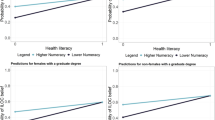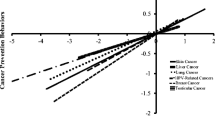Abstract
Participants in this study (N=178) were poorly informed about risk factors, warning signs, and self-examination (SE) practices for two common cancers in young adults, testicular cancer in men and breast cancer in women. Compared to women, men were less likely to know about, see the importance of, or practice SE. We found no relationship between internal locus of control, hypochondriasis, and loneliness, on the one hand, and cancer knowledge and SE, on the other. The best predictors of cancer awareness and SE were fear of developing cancer and self-rated confidence that SE was being done correctly. The results are consistent with a health belief model and self-efficacy theory of health behavior.
Similar content being viewed by others
References
Ajzen, I., and Fishbein, M. (1980).Understanding Attitudes and Predicting Behavior, Prentice Hall, Englewood Cliffs, NJ.
Alagna, S., and Reddy, D. (1984). Predictors of proficient technique and successful lesion detection in breast self-examination.Health Psychol. 2: 113–127.
American Cancer Society (1993).Cancer Facts and Figures.
Bandura, A. (1977). Self-efficacy: Toward a unifying theory of behavior change.Psychol. Rev. 84: 191–215.
Bundek, N., Marks, G., and Richardson, J. (1993) Role of health locus of control beliefs in cancer screening of elderly hispanic women.Health Psychol. 12: 193–199.
Butcher, J., Dahlstrom, W., Graham, J., Tellegen, A., and Kaemmer, B. (1989).Minnesota Multiphasic Personality Inventory-2 (MMPI-2). Manual for Administration and Scoring, University of Minnesota Press, Minneapolis.
Champion, V. (1988). Attitudinal variables related to intention, frequency, and proficiency of breast self-examination in women 35 and over.Res. Nursing Health 11: 283–291.
Cohen, S., and Syme, S. (1985).Social Support and Health, Academic Press, New York.
Craun, A., and Deffenbacher, J. (1987). The effects of information, behavioral rehearsal, and prompting on breast self-exams.J. Behav. Med. 10: 351–365.
Dachs, R., Garb, J., White, C., and Berman, J. (1989). Male college student's compliance with testicular self-examination.J. Adolesc. Health Care 10: 295–299.
Ganong, L., and Markovitz, J. (1987). Young men's knowledge of testicular cancer and behavioral intentions toward testicular self-exam.Patient Educ. Counsel. 9: 251–261.
Grady, K., Goodenow, C., and Borkin, J. (1988). The effect of reward on compliance with breast self-examination.J. Behav. Med. 11: 43–57.
House, J., Landis, K., and Umberson, D. (1988). Social relationships and health.Science 241: 540–544.
Kirscht, J. (1988). The health belief model and predictions of health actions. In Gochman, D. (ed.),Health Behavior: Emerging Research Perspectives, Plenum Press, New York, pp. 27–42.
Krietler, S., Chaitchik, S., and Krietler, H. (1990). The psychological profile of women attending breast screening tests.Soc. Sci. Med. 31: 1177–1185.
Maddux, J. (1993). Social models of health and exercise behavior: An introduction and review of conceptual issues.J. Appl. Sport Psychol. 5: 116–140.
Massey, V. (1988). Perceived susceptibility to breast cancer and practice of breast self-examination.Nursing Res. 35: 183–185.
Mischel, W. (1968).Personality and Assessment, Wiley, New York.
O'Leary, A. (1985). Self-efficacy and health.Behav. Res. Ther. 23: 437–451.
Quadrel, M., and Lau, R. (1989). Health promotion, health locus of control, and health behavior: Two field experiments.J. Appl. Soc. Psychol. 19: 1497–1521.
Rosenstock, I. (1974). The health belief model. Origins and correlates.Health Educ. Monogr. 2: 336–353.
Russell, D., Peplau, L., and Cutrona, C. (1980). The revised UCLA loneliness scale: Concurrent and discriminant validity evidence.J. Personal. Soc. Psychol. 39: 472–480.
Smith, I., Lancaster, C., Delbene, V., and Fleming, G. (1990). The relationship between medical student's locus of control and promotion of breast self-examination.Med. Educ. 24: 164–170.
Waldron, I. (1988). Gender and health-related behavior. In Gochman, D. (ed),Health Behavior: Emerging Research Perspectives, Plenum Press, New York, pp. 193–208.
Wallston, K., Walston, B., and DeVellis, R. (1978). Development of the Multidimensional Health Locus of Control Scales.Health Educ. Monogr. 6: 161–170.
Author information
Authors and Affiliations
Rights and permissions
About this article
Cite this article
Katz, R.C., Meyers, K. & Walls, J. Cancer awareness and self-examination practices in young men and women. J Behav Med 18, 377–384 (1995). https://doi.org/10.1007/BF01857661
Accepted:
Issue Date:
DOI: https://doi.org/10.1007/BF01857661




